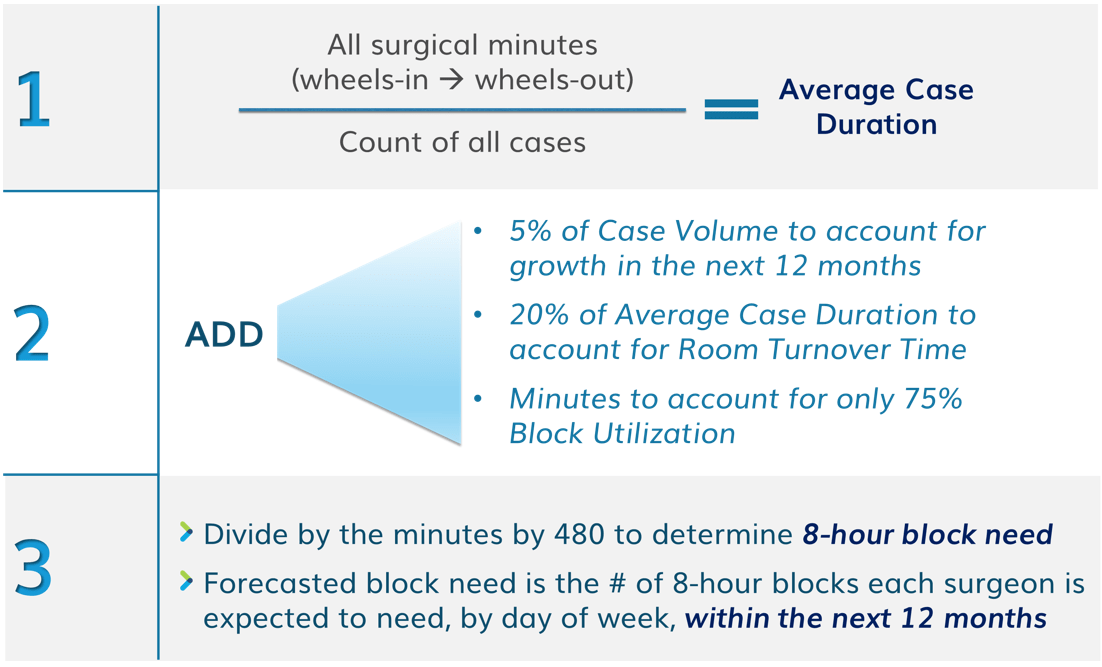
What if you could accurately predict, based on historic practice patterns, how many ORs you should block every day and what the block needs of your surgeons would be for the next 12 months?
Hospital politics and inertia. Overestimation of case volume by senior surgeons. Planning for too many or too few Operating Rooms.
These are just a few reasons why Surgical Services Departments struggle with block time allocation and monitoring, surgeon access, and appropriate OR utilization. Because an OR’s most valuable resource is its time, management of that time is of the utmost importance.
Increasingly, Surgical Services Departments around the country are facing one of two hurdles: their ORs are over-blocked and surgeons have limited access or their ORs are inefficient due to unpredictable scheduling.
Block Allocation: Universal Concerns
It’s complicated. Surgeons want a room when they want it. Anesthesiologists want rooms full between 7AM and 5PM, then only open for emergencies. Nurses want the rooms full between 7AM and 3PM, but closed 11:30AM-12PM. Hospital administrators want all the rooms running 24 hours a day while utilizing staff on straight time.
As a result, every hospital aims to balance surgeon needs for access, safety, and quality with the hospital’s need for OR productivity. However, the process is usually inexact and fraught instead of data-driven and transparent. In fact, initial block allocation tends to be difficult to alter, regardless of protocols that may be in place.
Enter a Data-Driven Block Need Forecasting process…
Right-Sizing Your OR Blocks:
Based on historic practice patterns and a few assumptions, your surgeons’ block needs – by day of week – can be predicted. The trick is accurate data extraction from your Electronic Medical Record and clear block utilization expectations. By manipulating the total surgical minutes used by a surgeon over the last 12 months, you can determine block need by surgeon.

Surgeon buy-in is critical to this process and the next step is to ask that the surgeons request blocks based on their forecasts. Because these forecasts are based on actual surgical minutes – not a block utilization percentage calculation that he or she might not agree with – they serve as an apolitical mechanism to optimize block time.
Once all surgeon block needs have been forecasted and block requests received, build an ideal block schedule, by day of week and week of the month. One thing to bear in mind is that since patients have usually met their deductibles by the fourth quarter of the year, surgical volumes tend to fluctuate – sometimes significantly – throughout the year. If the volume of your Surgical Services varies significantly by quarter, it is best to build the schedule based on quarterly practice patterns, not annual utilization.
What You Need for Success:
This process hinges on having all the relevant information – which hinges on reliable data and transparent block expectations, and a governance structure to enforce the guidelines.

A multidisciplinary governance structure should determine the block schedule expectations, disseminate the policies, and ensure compliance. The governing body decides which assumptions to use in the model, including block length minimum, block utilization thresholds, and growth factors. Typically there is a subcommittee that evaluates the forecasts, requests, considers the real-world constraints (e.g., only 12 ORs, only one robot, only two C-arms), and builds a new schedule.
After the block schedule has been redesigned and rolled out, you must ensure:
- Hospital administration empowers the governance committee to make all block schedule decisions
- Block utilization reports are shared at least quarterly with surgeons
- Alterations to the schedule are made according to policy and the guidelines are adhered to in a fair, transparent manner
A systematic, data-driven approach like block forecasting has been shown to have positive effects on OR culture and efficiency, improving surgeon satisfaction and increasing case volume.
Want to learn more about block scheduling? Check out our recent blog Maximizing Block Utilization
Be sure to scubscribe to our blog to ensure you dont miss out on more great information that will help improve your performance and positively impact your bottom line:



